

...it isn't just for disco anymore!

Polyesters are the polymers, in the form of fibers, that were used back in the seventies to make all that wonderful disco clothing, the kind you see being modeled on the right. In the last twenty years nicer polyester fibers have been made into fabric. These can be made into normal clothes that regular people wear, and polyester is very economical. So now you don't have to be a disco dancer or a lounge singer to wear polyester.
And polyester isn't just for clothes. It is also a plastic, often used to make shatterproof bottles that hold your favorite refreshing beverages, like the blue bottle in the picture. So you see, polyesters can be both plastics and fibers. Another place you find polyester is in balloons. Not the cheap ones that you use for water balloons, those are made of natural rubber. I'm talking about the fancy ones you get when you're in the hospital. These are made of a polyester film made by DuPont called Mylar.
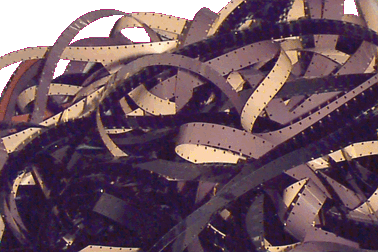 And speaking of film, polyester is also used to make motion picture film. The negatives and workprint for editing are still made from cellulose acetate, but the release prints that are run in movie theaters are often made of polyester because it's very strong and can hold up to being run through a projector hundreds or thousands of times.
And speaking of film, polyester is also used to make motion picture film. The negatives and workprint for editing are still made from cellulose acetate, but the release prints that are run in movie theaters are often made of polyester because it's very strong and can hold up to being run through a projector hundreds or thousands of times.
Now on to the chemistry! Polyesters have hydrocarbon backbones which contain ester linkages, That's why it's called polyESTER. The structures below will help you see atoms and bonds in the molecules.
This is what the monomer terephthalic acid bisethylene glycol ester looks like (left- click on it). And here's the polyester chain on the right. Pretty cool huh?
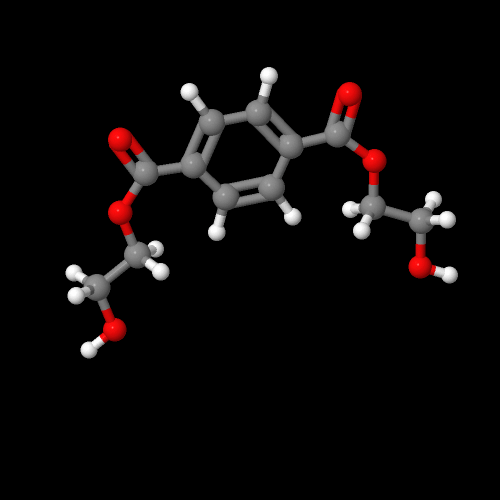
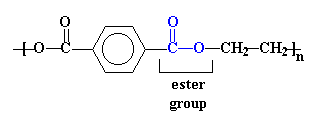
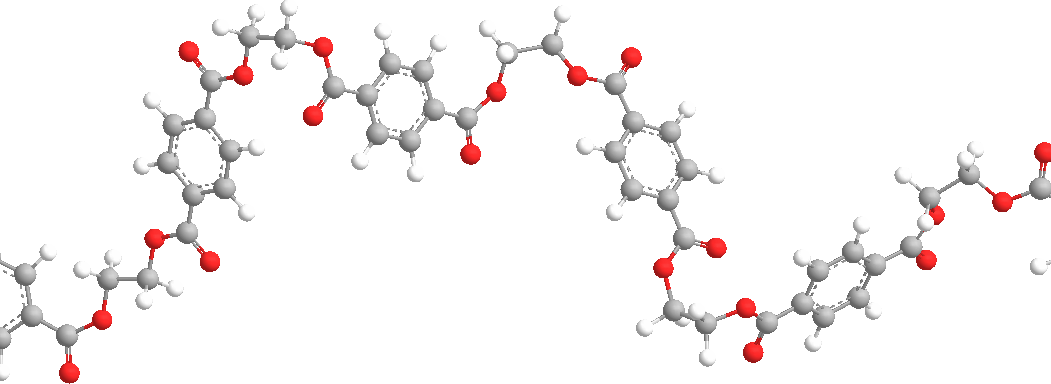
The structure above is called poly(ethylene terephthalate), or PET for short, because it is made up of ethylene groups and terephthalate groups. Click on the structure to pop up a 3D version you can manipulate in space.
PET is also a useful name because
"terephthalate" is not the kind of word most English-speaking mouths
are used to saying, but with practice you should be able to say it with
only a slight feeling of awkwardness when it rolls off your tongue. Just think of the "ph-th" sound as the same sound in the end of the word "fifth." Then it's not so hard. And you can impress all your friends when you tell them that polyester is really "poly(ethylene terephthalate)."

Shatterproof polyester has changed a lot of things in the food insdutry. Instead of returnable glass bottles, our soda comes in plastic. And so do other foods like peanut butter. Now I'm sure everyone out there is just dying to have two questions answered. The first one is:
Why can't you return plastic soft drink bottles to get a cool nickel per bottle like you could with the old glass bottles?
And the second one which I'm positive everyone is wondering about is:
How come peanut butter comes in neato shatterproof jars but jelly doesn't?
These two questions, as it turns out, have the same answer. In order to be reused, a soda bottle must be washed at a very high temperature to sterilize it. This heat would start to melt a bottle made out of PET, so it would become soft and lose it's shape. And down at the jelly factory they put the jelly into jars when it is still hot from cooking. It's so hot that if the jars were made from PET, the hot jelly would start to melt them also, so they have to be made of glass.
PEN Saves the Day!
There is a new kind of polyester that is just the thing needed for jelly jars and returnable bottles. It is poly(ethylene naphthalate), or PEN.
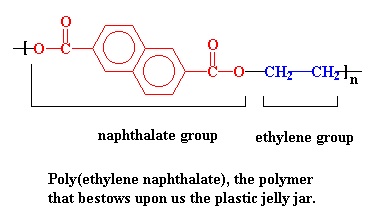
PEN has a higher glass transition temperature than PET. That's the temperature at which a polymer gets soft. The glass transition temperature of PEN is high enough so that it can withstand the heat of both sterilizing bottle washing and hot strawberry jelly. PEN is so good at standing the heat that you don't even have to make the bottle entirely out of it. Just mixing some PEN in with the old PET gives a bottle that can take the heat a lot better than plain old PET.
In fact, in Europe, where people are into being thrifty, and returning bottles for cash is still very common, some soda bottles are made with PEN. So people can reuturn their 2 liter soda bottles along with the glass bottles from other soda and beer and mineral water, and get some money back for them. Here in the USA it seems that recycling has become the thing to do, and returning bottles has almost become a thing of the past. So who knows if PEN will ever catch on here.
There are two more polyesters on the market that are related to PET. There is poly(butylene terephthalate) (PBT) and poly(trimethylene terephthalate). They are usually used for the same type of things as PET, but in some cases these perform better. And a special family of polyesters are polycarbonates. They're very hard and strong and are used to make shatterproof windows and eyeglasses.
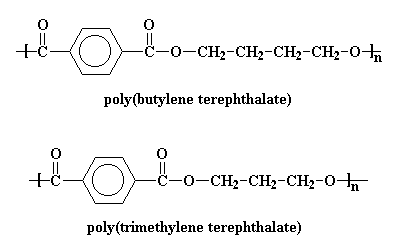
| Other polymers used as plastics include: | Other polymers used as fibers include: |
| Polypropylene | Polypropylene |
| Polyethylene | Polyethylene |
| Polystyrene | Nylon |
| Polycarbonate | Kevlar and Nomex |
| PVC | Polyacrylonitrile |
| Nylon | Cellulose |
| Poly(methyl methacrylate) | Polyurethanes |

|
Return to Kinds of Polymers |

|
Return to Main Page |